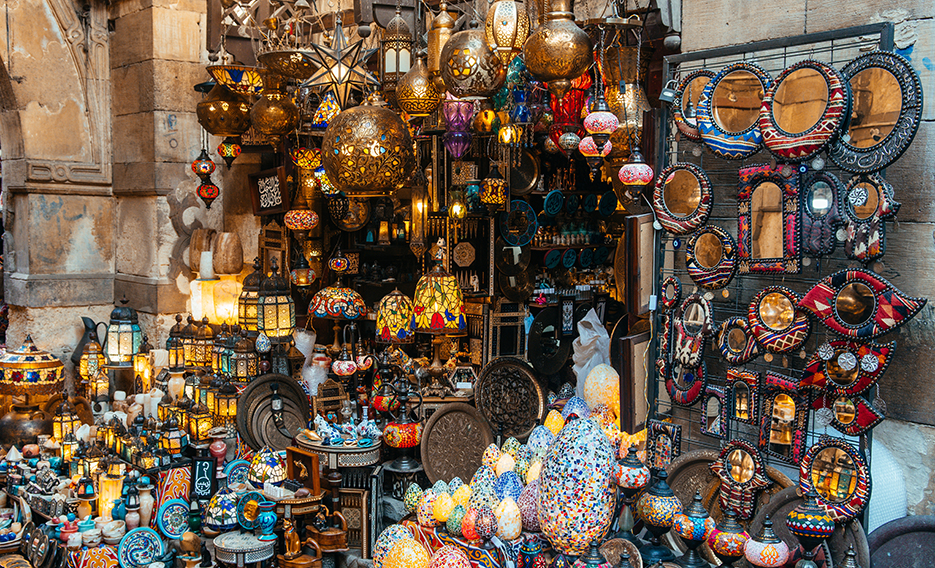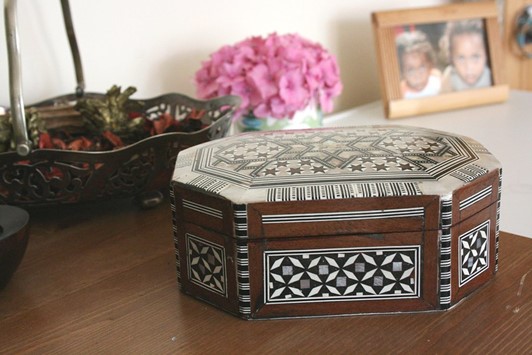POST
October 22 , 2022
Best Souvenirs to Buy in Egypt
Take home some traditional handicrafts from Egypt. These are the top items worth spending money on.

Cartouche pendants
Adorning temples, tombs and statues across Egypt, the cartouche is an oval-shaped marking with the name of a Pharaoh written inside. Today, archaeologists use these nameplates to decipher which ancient ruler an artifact belonged to. Silver and gold cartouche pendants are some of the most precious and personal souvenirs you can buy in Egypt. You’ll have your name etched in hieroglyphs to wear for good luck and protection from evil, just like the Pharaohs. Make sure to order in advance to give time for the engraving.

Image by Lo van den Berg from flickr
Amulets
In addition to the cartouche, there are many other amulets that you can find as jewelry pieces or precious objects with an imbued meaning. Ancient Egyptians wore amulets as jewelry or tucked into the folds of clothing to bestow protective or regenerative powers to the wearer. Bring home a bit of magic with these motifs …
* Scarab: The scarab beetle – who the ancient people saw rolling its ball of dung across the desert like the sun moves across the sky from day to night – symbolizes the sun god Ra, bringing renewal and rebirth.
* Ankh: The ankh, represented over and over in ancient writings and art, often in the hands of the depicted Pharaoh, is the ‘key of life’. Shaped like a cross with a loop at the top, it is an excellent gift that brings wishes of long life and health.
* Eye of Horus: Sometimes ancient amulets were inspired by deities, such as the falcon god Horus whose eye was injured by Seth and then magically restored. The wedjat, or Eye of Horus, was a very popular talisman in ancient times, bestowing healing powers to its owner.
* Lotus: The fan-shaped lotus flower, which closed at night and opened again each morning, was another symbol of rebirth and regeneration. All over the ancient temples and tombs, you’ll see the papyrus symbolizing Lower Egypt, and the lotus flower symbolizing Upper Egypt.

Image by Brian Chiu from flickr
Alabaster pieces
The ancient Egyptians used white alabaster stone to make the smooth, translucent perfume jars and vessels used in mummification. Today alabaster factories are all around Luxor, the best place to buy decorative sculptures, vases and small items like alabaster scarabs, pyramid replicas, and statues of the feline goddess Bastet.

Image by ohhenry415 from flickr
Inlay boxes
Pretty wooden boxes inlaid with decorative designs are an excellent way to bring home a uniquely Egyptian artisanal piece. For centuries, regional art and furniture has featured inlay work, a technique used to adorn the wooden shrines and coffins of ancient Egypt. Today you can find inlay boxes of all different sizes for holding your treasures and giving as gifts. The ornate designs reflect the Islamic geometric patterns that you’ll see on many historical Egyptian landmarks. The boxes may be inlaid with mother-of-pearl, slivers of bone, conch shells or even plastic depending on where you buy them. You could also find hardwood backgammon boards with inlay work.

Image by Sally from flickr
Edible souvenirs
* Dates: Egypt is the world’s biggest date producer, and the Siwa Oasis in the Western Desert cultivates the most prized dates of the region. If you can’t find Siwa dates, Medjool dates are the most well-known variety. Sticky sweet, desiccated dates are perfect for packing and carrying on the plane. Dried dates are generally allowed to bring back to the US, but they should be declared on your US Customs form. And don’t forget, before you leave Egypt, you must try the fresh dates!
* Coffee with cardamom: Most Egyptians prefer to drink coffee Turkish-style – finely ground and prepared on the stovetop. You can pick up a bag or two of soft, aromatic ground coffee from the most popular brand Al-Yemeni Café, dating back to 1940. It’s sold at most grocery stores in different roast and flavor varieties. The blends with cardamom are something unique to try.
* Hibiscus: Hibiscus is another dried good worth buying in Egypt. The deep pink flowers are used to make the traditional drink karkade – just boil the dried hibiscus in water, add sugar to taste, and let chill in the fridge if making a refreshing drink for summer. It’s said to be great for regulating blood pressure too.
* Za’atar: Popular throughout the middle east, this is a type of wild oregano that also gives its name to a much-beloved spice blend that typically includes the dried za’atar herb, thyme, sumac, and toasted sesame seeds. Serve it with olive oil for dipping, or sprinkle it generously on warm flat bread. This is yet another ingredient that has a range of touted health benefits.

Image by Ella Olsson from flickr
Painted papyrus
Take a piece of history home with you when you buy an artwork painted on real papyrus. An important writing material for the ancients until cheaper pulp fiber paper came along, the papyrus making technique was revived in the 1960s. Today, the sheets are mostly used in decorative art. Be aware that much of the papyrus you’ll find for sale on the streets is made from dried banana stalk or another fake material. The real papyrus will be heavier and not so easily torn, and of course more expensive than the knock-off versions. If you want the real thing, it’s best to ask a trusted private guide to take you to a specialist shop.

Image by Vyacheslav Argenberg from flickr
Textiles
* Egyptian cotton: Cotton grown in Egypt, thanks to the Nile River valley’s nutrient-rich soil, has a reputation for yielding the finest fibers that produce the most luxurious sheets and towels. The advantage of buying here is to avoid import taxes, but there is a lot of inferior product sold at the markets, so make sure you ask a guide to steer you toward a reputable shop. Egyptian cotton sheets can last for 15-20 years and only get better and better each time you wash!
* Carpets: Egypt is not as renowned for its carpets like Turkey or Iran, but there’s an area nearby the ancient pyramids of Saqqara in Cairo where you can find handmade souvenirs woven with pharaonic images and intricate designs. A few carpet weaving schools are passing the tradition down to the younger generation.
* Kilims: Decorative and practical, kilims portray geometric and traditional motifs formed by a flat weaving technique. These pieces are thinner and more lightweight than carpet and can be used as rugs, mats, decorative throws and wall hangings. You’ll find a curated selection at the ‘Kiliim’ boutique in Maadi, a Cairo district popular with expats.

Image by Julia Volk from pexels
Cairo Boutiques & Antiques
If you have the time, spending an afternoon browsing some local shops in leafy neighborhoods like Zamalek or Maadi will give you a nice idea of modern life in Cairo. Away from the touristy bazaars like Khan el-Khalili, you don’t have to worry about haggling, or whether the items are made in China. Shop at these local boutiques to support artisans from around Egypt …
‘Fair Trade Egypt’ (with shops in Zamalek, Maadi, and Heliopolis) is an excellent place to find a variety of traditional handicrafts. The ‘Cairopolitan’ design concept store in Garden City (close to the Four Seasons Nile Plaza) is great for printed gifts that mix contemporary art with Egyptian cultural symbols. At the boutique of ‘Nevin Altmann’ (in Zamalek and Maadi), you’ll encounter the art of handstitched embroidery showcasing colorful one-of-a-kind patterns on clutches, bags, scarves, cushions and more. Also on Zamalek island, the ‘Altay’ gift shop has a great selection of accessories and souvenirs.
For antiques, you can wander the shops in Zamalek, where old books, jewelry, paintings and trinkets are waiting to come home with you as a keepsake of your journeys through Egypt.

Image by gaelx from flickr